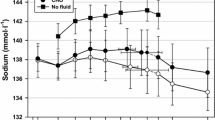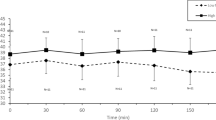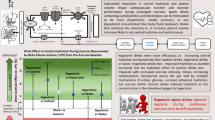Summary
The effect of an imposed drinking discipline versus ad libitum drinking was studied on 21 healthy, well-trained volunteers, during a continuous 4.5-h march at an altitude of 1,700 m and an ambient temperature of 0° C, SD 1. Group I (n = 13) was instructed to drink 250 ml of warmed, artificially sweetened fluid every 30 min, whereas group II (n = 8) drank plain water ad libitum. The median fluid intake in group I was significantly higher than in group II (P < 0.0002). Serum urea and osmolality decreased during the march in group I (P < 0.05; P < 0.002, respectively) with no significant change in group II. In both groups, a similar increase in haemoglobin concentration concomitant with a reduction in calculated blood and plasma volume was observed after exercise and did not correlate with the state of hydration. Total urine volume, creatinine clearance, urea clearance and potassium excretion were significantly higher and urinary osmolality was lower in group I than in group II (P < 0.05). These results reflect a state of extreme “voluntary dehydration” in the control group when no fluid intake was obligatory. Thus, during exercise in the cold, under conditions similar to those in this study, a fluid intake of 150 ml · h−1 should be maintained in order to keep a urinary flow of about 1 ml · kg−1 · h−1 and to achieve a good state of hydration.
Similar content being viewed by others
References
Bader RA, Eliot JW, Bass DE (1952) Hormonal and renal mechanism of cold diuresis. J Appl Physiol 4:649–658
Bingham SA, Cummings JH (1985) The use of creatinine output as a check on the completeness of 24 hour urine collections. Hum Nutr Clin Nutr 39C:343–353
Blume FD, Boyer SJ, Braverman LE, Cohen A, Dirkse J, Mordes JP (1984) Impaired osmoregulation at high altitude. JAMA 252:524–526
Costill DL, Fink WJ (1974) Plasma volume changes following exercise and thermal dehydration. J Appl Physiol 37:521–525
Davis GL, Abildgaard CF, Bernauer EM, Britton M (1976) Fibrinolytic and hemostatic changes during and after maximal exercise in males. J Appl Physiol 40:287–292
Dill DB, Costill DL (1974) Calculation of percentage change in volumes of blood, plasma, and red cell in dehydration. J Appl Physiol 37:247–248
Fregly MJ (1982) Thermogenic drinking. Mediation by osmoreceptor and angiotensin 11 pathways. Fed Proc 41:2515–2519
Galun E, Burstein R, Assia E, Tur-Kaspa I, Rosenblum J, Epstein Y (1987) Changes of white blood cell count during prolonged exercise. Int J Sports Med 8:253–255
Greenleaf JE, Brock PJ (1980) Na+ and Ca +2 ingestion. Plasma volume — electrolyte distribution at rest and exercise. J Appl Physiol 48:838–847
Guilland JC, Klepping J (1985) Nutritional alternation at high altitude in man. Eur J Appl Physiol 54:517–523
Hartmann G, Oberli H (1979) Nutrition and heavy alpine physical performance. Bibl Nutr Dieta 27:126–132
Jacobsen FK, Christensen CK, Mogensen CE, Heilskov NSC (1980) Evaluation of kidney function after meal. Lancet 2:319(letter)
Jones G, Lee K, Swaminathan R (1985) Glomerular filtration response to acute protein load. Lancet 2:838 (letter)
Legg SJ, Mahanty A (1986) Energy cost of backpacking in heavy boots. Ergonomics 29:433–438
Maresh CM, Wang BC, Goetz KL (1985) Plasma vasopressin, renin activity, and aldosterone responses to maximal exercise in active college females. Eur J Appl Physiol 54:398–403
Muchmore HG, Blackburn AB, Shurley JT, Pierce CM, McKown BA (1970) Neutropenia in healthy men at the south polar plateau. Arch Intern Med 125:646–648
Radomski MW, Boutelier C (1982) Hormone response of normal and intermittent cold preadapted humans to continuous cold. J Appl Physiol 53:610–616
Rocker L, Franz IW (1986) Effect of chronic B adrenergic blockade on exercise induced leukocytosis. Klin Wochenschr 64:270–273
Rodriguez-Iturbe B, Herrera J, Gracia R (1985) Response to acute protein load in kidney donors and in apparently normal post acute glomerulonephritis patients. Evidence for glomerular hyperfiltration. Lancet 2:461–464
Rogers TA, Setliff JA, Klopping JC (1964) Energy cost, fluid and electrolyte balance in subarctic survival situations. J Appl Physiol 19:1–8
Rotstein A, Bar-Or O, Dlin R (1982) Hemoglobin, hematocrit and calculated plasma volume changes induced by a short supramaximal task. Int J Sports Med 3:230–233
Segar WE, Moore WW (1968) The regulation of antidiuretic hormone release in man. J Clin Invest 47:2143–2151
Senay LC, Kok R (1977) Effects of training and heat acclimatization on blood plasma contents of exercising men. J Appl Physiol 43:591–599
Strauss MB, Davis RK, Rosenbaum JD, Rossmeisl EC (1951) “Water diuresis”, produced during recumbency by the intravenous infusion of isotonic saline solution. J Clin Invest 30:862–868
Wagner JA, Horvath SM, Kitagawa K, Bolduan NW (1987) Comparisons of blood and urinary responses to cold exposure in young and older men and women. J Gerontol 42:173–179
Watanabe K, Kugeyama T, Azuma T (1967) Physiological acclimatization during the fourth Japanese Antarctic Expedition (1959–1961), vol. 2. In: Tromp SW, Weihe WH (eds) Biometeorology. Pergamon Press, Oxford, pp 880–883
Williams ES, Ward MP, Milledge JS, Withey WR, Older MWJ, Forsling ML (1979) Effect of the exercise of seven consecutive days hill-walking on fluid homeostasis. Clin Sci 56:305–316
Wyant KW, Caron PL (1983) Water discipline and an arctic ration prototype. Milit Med 148:435–438
Author information
Authors and Affiliations
Rights and permissions
About this article
Cite this article
Dann, E.J., Gillis, S. & Burstein, R. Effect of fluid intake on renal function during exercise in the cold. Eur J Appl Physiol 61, 133–137 (1990). https://doi.org/10.1007/BF00236707
Accepted:
Issue Date:
DOI: https://doi.org/10.1007/BF00236707




